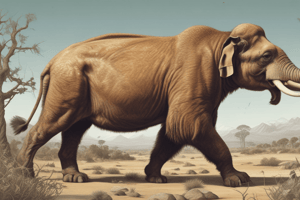Podcast
Questions and Answers
What are the two pairs of limbs in mammals adapted for?
What are the two pairs of limbs in mammals adapted for?
walking, running, burrowing, and swimming or flying
How many chambers are there in the heart of mammals?
How many chambers are there in the heart of mammals?
- Four (correct)
- Five
- Three
- Two
Mammals are cold-blooded animals.
Mammals are cold-blooded animals.
False (B)
The chain of bones in the ear of mammals consists of Incus, Malleus, and ________.
The chain of bones in the ear of mammals consists of Incus, Malleus, and ________.
Match the subclass of Class Mammalia with their description:
Match the subclass of Class Mammalia with their description:
Flashcards are hidden until you start studying
Study Notes
Physical Characteristics
- Body is divided into head, neck, trunk, and tail, and can be variously shaped
- Two pairs of pentadactyl limbs adapted for different activities (walking, running, burrowing, swimming, or flying)
- Skin is glandular and mostly covered with hair
- Coelom is completely divided into anterior thoracic cavity and posterior cavity by a muscular partition, the diaphragm
- Endoskeleton is fully ossified
- Skull has two occipital condyles and a large cranium
- External ear pinna is present
- Chain of three bones in ear consists of Incus, Malleus, and Stapes
- Mammals have deciduous and permanent teeth
Internal Characteristics
- Heart has four chambers
- Only left aortic arch is present
- RBC are non-nucleated
- Mammals are warm-blooded animals (endothermic)
- Voice apparatus is well developed and consists of larynx and epiglottis
Reproduction
- Mammals give birth to their young ones
- Three subclasses of mammals: Prototheria, Metatheria, and Eutheria
Subclass Prototheria
- Provide connecting links between reptiles and mammals
- Some are adapted to aquatic life (e.g., duck-billed platypus)
- Have mammary glands and feed their young ones with milk
- Are ovi-viviparous
- Possess cloaca and cloacal opening, like reptiles
- Examples: duck-billed platypus, spiny ant eater (Echidna)
Subclass Metatheria
- Female has an abdominal pouch called marsupium to nurture their young ones
- Nipples are in the pouch
- Mother keeps young ones in a pouch till they are mature enough
- Give birth to underdeveloped babies
- Found in Australia and America
- Examples: opossum, kangaroo, Tasmanian wolf
Subclass Eutheria
- Development of young one takes place inside the body of the mother
- Young ones are born fully developed
- Dependent on placentas (an organ for exchange between maternal blood and fetal blood)
- Examples: man, whale, elephant, horse, rat, bat, dolphin, lion, gorilla
Studying That Suits You
Use AI to generate personalized quizzes and flashcards to suit your learning preferences.




